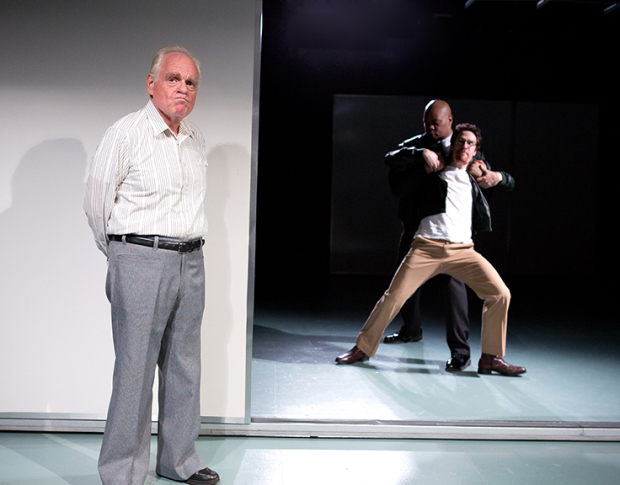by Samuel L. Leiter
The Burial at Thebes, Irish poet and Nobel laureate Seamus Heaney’s sharp-as-a-dagger adaptation of Sophocles’ 441 BC Greek tragedy Antigone, joins the small number of premodern classics presented since 1988 by the Irish Repertory Theatre, typically given over to modern dramas by Irish and Irish-American authors. As unostentatiously staged by the IRT’s artistic director, Charlotte Moore, with a solid company of well-spoken, variously-accented American, British, and Irish actors, the play reminds us once again why we keep returning to the Greek well for critical contemplations of universal issues.
Originally commissioned for the 2004 centennial of Dublin’s Abbey Theatre, and seen in 2007 at New York’s La Mama (it was turned into an opera in 2008), The Burial at Thebes gives much of Heaney’s eloquent, accessible, and sometimes colloquial mixture of verse and prose a decided Irish inflection. Moore’s production abandons Heaney’s chorus of elders, dividing its lines between Eurydice (Winsome Brown), the Guard (Colin Lane), and, mainly, the Messenger (Rod Brogan); earlier productions typically used three men or women for the chorus, allowing them opportunities for song and dance, absent here. The plot remains faithful to Sophocles, albeit sharpened to reflect Heaney’s wish to underline the parallels between Creon’s “either/or” demands and those of President Bush on invading Iraq. As Moore, summing up Heaney’s point, notes in the program, “If you don’t support the eradication of the tyrant in Iraq and the threat he poses for the free world, you are on the wrong side in the ‘war on terror.’”


Colin Lane as the Guard, Katie Fabel as Ismene, Paul O’Brien as Creon, and Rebekah Brockman as Antigone
Heaney’s title, of course, refers to the burial of the late King Oedipus’ son, Polyneices, who died warring against Thebes, while his brother, Eteocles, was killed fighting on the other side. King Creon (Paul O’Brien), the brothers’ uncle, seeking to bolster patriotic feelings and establish his newfound power, declares that, in contrast to the heroic Eteocles, Polyneices is a traitor and his body shall remain unburied and exposed to the elements. Antigone (Rebekkah Brockman), sister of Polyneices and Eteocles, is unable to accept this unholy dictate; ignoring her sister Ismene’s (Katie Fabel) pleas, she defies the ruler by burying her sibling’s corpse (a symbolic act signified by “a coat of dust”). Creon, standing firm despite attempts to sway him—by his son, Haemon (Ciarán Bowling), and his wife, Eurydice (Winsome Brown)—imprisons Antigone in a cave, ultimately leading to the suicides of Haemon and Eurydice. When Creon, heeding the words of the blind seer, Tiresias (Robert Langdon Lloyd), finally recognizes what he’s done, which Bush never did, it’s too late.
As in Sophocles, Heaney’s adaptation focuses on the conflict between Antigone’s wish to give her brother the interment she insists is his right, traitor or no, and Creon’s insistence that he be forbidden that right. Even though Creon is meant to remind audiences of Bush and Iraq, little of this seems evident, and the play stands or falls not so much on its contemporary references but on the power of its depiction of two proud, stubborn, and immovable individuals, each fighting for their own position, and unwilling to compromise. The classic conflict between the state and the individual and civil versus religious rights has never been so well articulated.
Unlike Alexander Harrington’s stylized, ritualistic production at La Mama, with its masklike makeup, Moore’s lacks noteworthy theatrical flourishes. Tony Walton’s simple setting, enhanced by Brian Nason’s lighting, shows vertical ropes forming several column-like shapes. Linda Fisher’s subdued, classically-inspired costumes fit nicely into this austere background; they make no attempt to comment on contemporary politics.
O’Brien—playing a role for which John Cullum originally was announced—delivers a believably human and suitably commanding Creon but slumps a bit during his tragic downfall. (Creon’s arrogance is such that one could even see the possibility of giving him Trump-like—if not Bush-like—touches, if it were possible to do so without making it comic.) Brockman’s monotonous, uncharismatic Antigone is compensated for by Lloyd’s Tiresias, whose pleading is a model of rhetorical mastery. The Irish element is most evident in Lane’s frightened Guard, offering a hint of humor in this Theban wasteland, and Brogan’s broguish Messenger.
When New York digs itself out of its own current burial under more than a coat of snow, theatergoers will find that visiting this 80-minute, modern version of an ancient text will be worth the effort. It stirs up many thoughts, not least of which are those regarding the unsettling rhetoric about leadership being mouthed during this year’s presidential campaign.
The Burial at Thebes. Through March 6 at the Irish Repertory Theatre – DR2 Theater (103 East Fifteenth Street, at Union Square East). www.IrishRep.org























